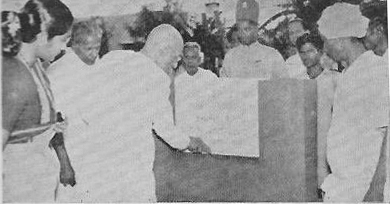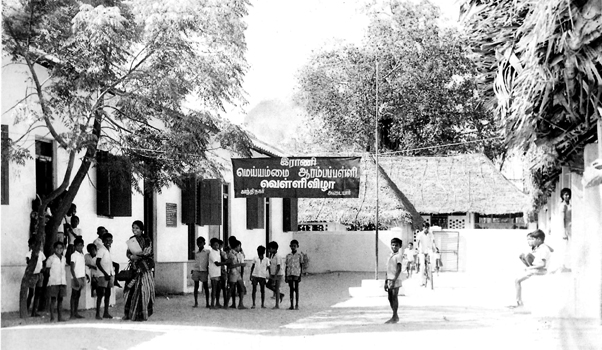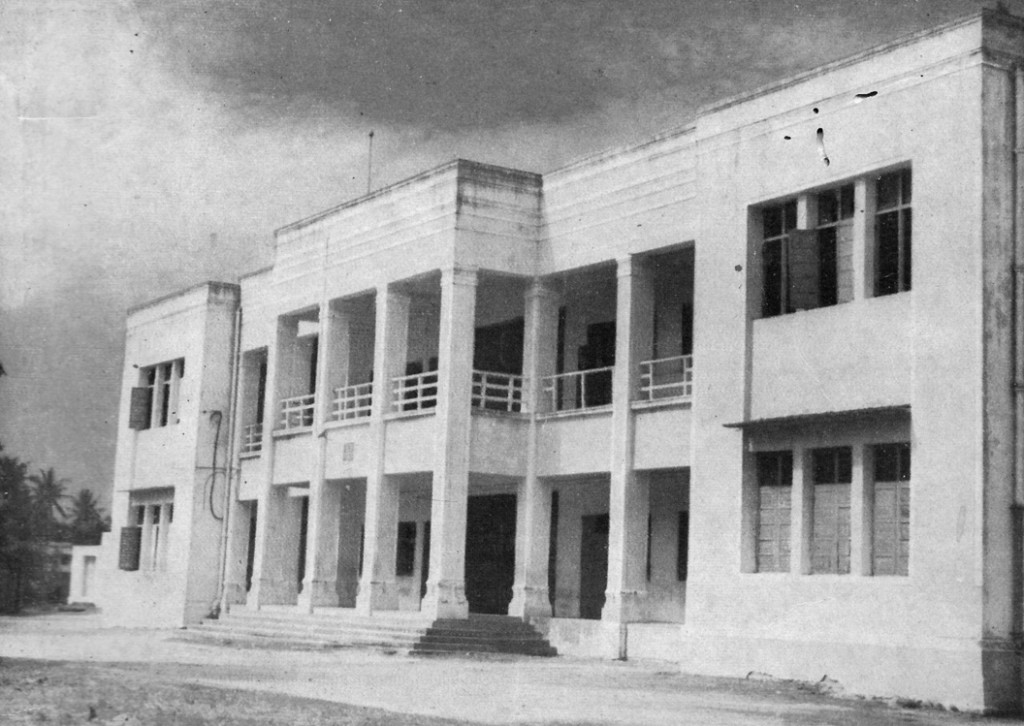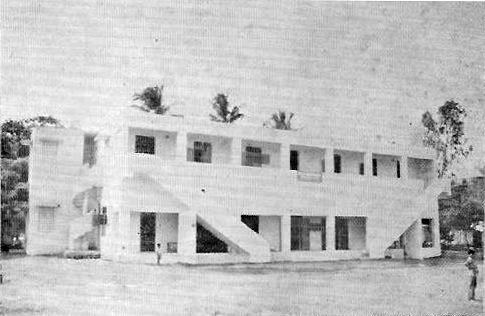Registered with the Registrar of Newspapers for India under R.N.I 53640/91
Vol. XXVIII No. 2, May 1-15, 2018
Bringing education to Gandhi Nagar
by V.S. Ravikumar vsoca@gmail.com
Birth of a Colony – 2
(Continued from last fortnight)

C.Rajagopalachari laying the foundation stone for the school building in 1955.
With the construction of bungalows in full swing in Gandhi Nagar, buyers started occupying them from early 1950s. Builders of gated community nowadays also announce a school in the complex. Most buyers look for this so that children need not commute to a school a distance far away. A similar need arose for the residents of Gandhi Nagar.
The colony already had St. Patrick’s School in the area established in 1875. Back then, it was mostly providing education to Anglo-Indians in Madras and was a boarding school. Besant Theosophical School was another educational institution; it functioned in Besant Avenue. Other schools were located in the far away Mylapore area. My two elder sisters went to Besant School, they had a hand- pulled rickshaw which took them to school every day.

Primary School Classes – 1976.

New Building – 1961.

Building – 1980.
The need for more schools in the colony itself was much felt. A nursery was started for children in the age group 2-5 by three visionary ladies of the colony, V. Savithri Ammal, R. Balamma and Rukmani Sampath in September 1951. Named Bala Brindavan, the school was founded as a social welfare organisation and registered under the Societies Registration Act, 1860. It was started on Vijayadasami Day in October, 1951. In the early years, the nursery classes were held in the house of Rukmani Sampath in 4th Main Road and I was a student in 1954/1955. We were given a variety of toys to play with and compulsory sleeping was part of the daily time table! Teachers took personal interest in the students. The house is now staff flats for employees of the Indian Overseas Bank, named as Overseas Brindavan.
The Madras House Construction Society in 1954 allotted six grounds of land on a 99-year lease to the school in 4th Main Road on the western side of the present Bala Vidaya Mandir school. In 1955, the PWD leased that 4 grounds of land in Kottur and a free nursery for children of the colony was started by the school.
In April 1955, the foundation stone for the school building in Gandhi Nagar was laid by C.Rajagopalachari. Building with a thatched roof was constructed to accommodate the children.
In 1965, one more room was added and the entire building was provided with concrete ceiling. It was opened by M. Bakthavatsalam. In 1968, the nursery school was up-graded to a primary school.
As the need for sufficient place for future development was felt, the school negotiated with the Gandhi Nagar Co-operative Housing Society to purchase 23 grounds of vacant land adjacent to the building. It comprised ditches, two ponds and an an open air theatre at the eastern end which was known as Kalki Mandapam. It was named after the famous Tamil writer Krishnamurthy (Kalki) who was a resident of 4th Main Road. The land was acquired for a sum of Rs.48,000 through donation and bank loan.
Our house was just opposite the two ponds and during the rainy season the overflowing water from the ponds would submerge the road. We could hear the continuous croaking of frogs. Frogs and water snakes would enter our garden.
The ponds and ditches were filled with the help of the Corporation of Madras and the Health Department in the mid-1970s to enable construction of a building. According to the original layout, the ponds were to be made into a swimming pool. But, in fact, the colony got a school, and lost two large water bodies.
Bala Brindavan became Bala Brindavan Secondary School. Class rooms were constructed in the filled up area in many phases.
In the 1990s, the school further developed under the wings of Vidya Mandir School, Mylapore. Its curriculum became more structured following the CBSE pattern. Vidya Mandir then gave back the reins of administration to the school and it became Bala Vidya Mandir School. It has been a very sought after school in the city ever since.
The colony should be deeply indebted to the three ladies who sowed the seeds for a great institution.
While Bala Brindavan, took almost three decades to grow into a full-fledged higher secondary school, another institution, started almost at the same time, developed very fast.
The by-laws of the Madras Co-operative House Construction Society provided for the running of educational institutions for the benefit of residents. So, it was decided to approach the House Construction Society to run a primary school. The President of the Society, K. Venkataswamy Naidu, readily agreed to the proposal. In 1950, a committee of some of the local residents was constituted with Rao Bahadur P.K. Gnanasambanda Mudaliar as President.
In the original layout of the colony, a small bit of land was reserved for a school on Crescent Avenue Road, behind the present Bala Vidya Mandir School and adjacent to a big pond. The committee decided to start a school on that land. Thus was started the “Gandhi Nagar School”, for which the foundation stone was laid in June 1950. It was opened in July 1950. S.R. Kaiwar, i.c.s. was the first Chairman of the Committee. A beautiful building, Shantha Memorial Hall was constructed on the land and given to the school by Col. Ramana Rao, a resident of the colony, and father-in-law of S.R. Kaiwar. From 1950 to 1954, it was a primary school with five standards and a Telugu medium section.
When the young children who were then in primary school had reached the secondary stage, the Housing Society could not continue to undertake the responsibility of running the Secondary School. It was decided in April, 1954 by the local residents that a new society be formed for better management of the school. Thus was formed “The Gandhi Nagar Education Society” registered under Societies Registration Act of 1860 in May, 1954 by a Memorandum of Association signed by seven residents who took lead in the formation. They were: (1) K.S. Ramamurthi, Executive of an insurance company; (2) C. Ranganatha Aiyengar, a retired Headmaster; (3) K. Veeraswami, who later became Chief Justice of Madras; (4) C.S. Hariharaputra Iyer, first occupant of the colony; (5) G.D. Boaz, Professor of Psychology; (6) V. Soundararajaan, a practicing Chartered Accountant; and (7) R. Balamma, one of the founder members of Bala Brindavan.
The Society faced financial problems. Funds were required not only for day-to-day maintenance but also for expansion. The Society approached Vaiydasubramania Iyer, Secretary to Raja Sir. M.A. Muthiah Chettiar of Chettinad, for donation from the Raja of Chettinad and to take over the Society under his patronage. K.S. Ramamurthi, V. Soundararajan, V. Nataraja Iyer and C.S. Hariharaputra Iyer played a notable role in obtaining his consent to associate formally with the Society from June, 1956.
With the Raja of Chettinad family in control, funds were made available as donations. Soon, thatched-roof classrooms were constructed and secondary classes were started. The school was renamed Rani Meyyammai High School and the primary school was called Rani Meyyammai Primary School.They were co-educational schools.
The first batch of SSLC passed out from the school in March, 1959. They had studied in the Tamil medium. The English medium sections were started in 1960 and the first batch of English medium SSLC passed out in March, 1967.
The campus had three huge banyan trees and students used to swing hanging on to its roots often inviting the wrath of the teachers or the headmaster. Several Kodukka puli trees used to abutt the pond. Climbing that tree and plucking the pod for its pulp was our pastime in the evenings.
The Telugu medium section was closed in 1958 due to reduction in the number of students and on formation of separate Andhra Pradesh state.
In June, 1961 a two-storeyed building was constructed at a cost of Rs.1.5 lakhs to accommodate the high school sections. The school got permanent recognition from Director of Public Instruction in June, 1962.
Four Schools were started by the Society in Rajah Annamalipuram from 1956 to 1961. Till 1971 the high school was co-educational. A separate institution for girls was started on 4th Main Road and was named Rani Meyyammai High School. The boys school was renamed the Kumararajah Muthiah High School.The pond has still given way to a college.
(To be continued)

